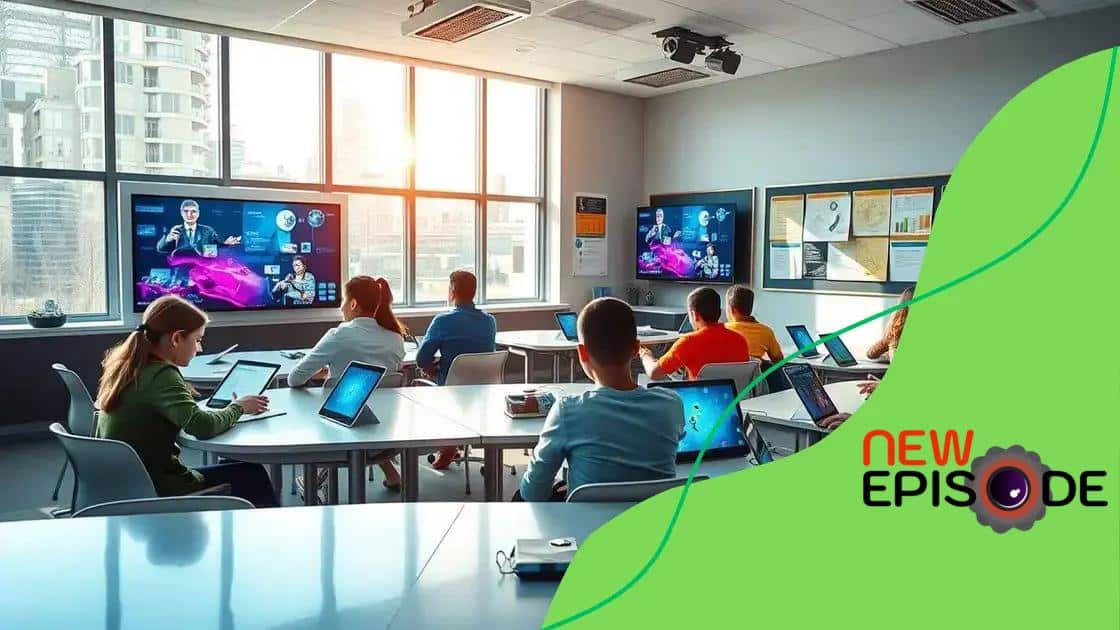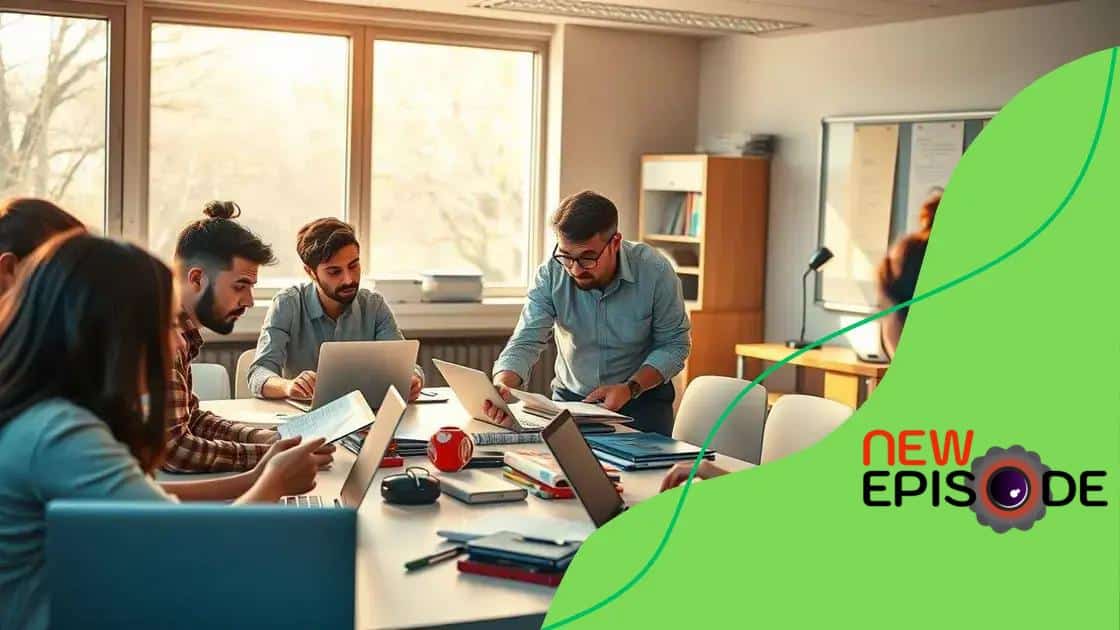How flipped classrooms are evolving in modern schools

Flipped classrooms revolutionize education by allowing students to learn at home and engage in interactive activities during class, enhancing engagement and fostering deeper understanding through the effective use of technology.
How flipped classrooms are evolving in modern schools is reshaping the way students learn and teachers teach. Have you ever wondered how this approach could make education more engaging? Let’s dive in.
Understanding the flipped classroom model
The flipped classroom model changes the way students learn by reversing traditional teaching methods. Instead of lectures being delivered during class, students study the material at home and engage in hands-on activities in class. This innovative approach encourages active learning, helping students grasp concepts more effectively.
Key Principles of the Flipped Classroom
The core principles of a flipped classroom include:
- Student-Centered Learning: Students take charge of their own learning by watching video lectures at their own pace.
- Active Engagement: Class time is used for discussion, collaboration, and problem-solving.
- Diverse Learning Resources: Teachers use a variety of resources like videos, articles, and interactive tools.
This model allows teachers to provide more personalized support, focusing on addressing individual student needs. Students arrive at class prepared to discuss the material, which fosters deeper understanding.
Benefits for Students
Implementing a flipped classroom offers several advantages. Not only does it maximize classroom time, but it also allows students to learn in a way that suits their own schedule. Students can revisit lectures, pause, or rewind to ensure they understand the content. This flexibility accommodates different learning styles, optimizing the overall educational experience.
In a flipped classroom, students also become more responsible for their own education. They prepare for class activities in advance, promoting independence and critical thinking skills. This process enhances collaboration amongst peers, allowing them to support one another in their learning journeys.
Challenges Faced by Educators
Despite the benefits, educators may face challenges when implementing this model. Not all students may have access to technology at home, which can create disparities in learning. Additionally, teachers need to design quality content that is engaging and effective.
Training and professional development for teachers are crucial components of successful implementation. By overcoming these challenges, schools can create a more equitable learning environment that embraces flipped classrooms.
Benefits of flipped classrooms for students
The benefits of flipped classrooms for students are numerous and impactful. This approach promotes active learning and encourages students to take ownership of their education. In a flipped classroom, students engage with materials at home, freeing up class time for interactive activities that reinforce their understanding.
Enhanced Engagement
Students often find flipped classrooms more engaging. By watching videos or reading materials at their own pace, they can focus on areas where they need more help. This accessibility leads to increased participation during class discussions, making learning a collaborative experience.
- Peer Collaboration: Students work together, sharing insights and tackling problems as a team.
- Direct Feedback: Teachers provide immediate assistance during class, addressing misconceptions right away.
- Motivation to Learn: The opportunity to learn outside of the classroom fosters a sense of responsibility.
Another significant benefit is the ability to customize learning. Students can revisit lessons and review complex topics until they feel confident. This self-directed approach nurtures a deeper understanding of course material, as they can absorb the information more thoroughly.
Improved Academic Performance
Research shows that students in flipped classrooms often demonstrate improved academic performance. They tend to score higher on tests and assignments compared to traditional classroom settings. This success is attributed to the increased amount of time spent practicing skills and engaging with the material actively.
Furthermore, with flipped classrooms, teachers can tailor their instruction to meet diverse learning needs. This individualized support helps struggling students catch up while challenging advanced learners to expand their knowledge.
Ultimately, the flipped classroom model not only improves student learning outcomes but also transforms the traditional educational landscape, making it more inclusive and effective for everyone involved.
Challenges educators face with flipped classrooms

Despite the advantages of the flipped classroom model, educators encounter various challenges when implementing it. Adapting to this approach requires significant changes in teaching methods and resources, which can be difficult for some educators.
Access to Technology
One of the most pressing issues is ensuring that all students have access to the necessary technology at home. Without reliable internet or devices, some students may be left behind. This digital divide creates disparities in learning, making it essential for schools to find ways to provide resources for all.
- Device Availability: Schools may need to invest in laptops, tablets, or other devices.
- Internet Access: Providing hotspots or free internet services for students can help bridge the gap.
- Support for Families: Educators can offer guidance to families on accessing and utilizing technology.
Another challenge educators face is the need to create high-quality content. Videos and other resources must be engaging and informative, which requires time and effort. Teachers must develop materials that suit diverse learning styles and preferences, which can be overwhelming.
Redefining Class Time
Reimagining the use of class time also presents difficulties. Some educators struggle with transitioning from a traditional lecture format to active, hands-on learning. This shift may require professional development to help teachers learn new strategies and techniques.
Additionally, classroom management becomes crucial in a flipped setting. Teachers need to foster a collaborative environment while ensuring all students remain engaged. Balancing group work with individual learning can be challenging and requires skillful facilitation.
Finally, assessing student learning can be more complex in a flipped classroom. Traditional testing methods may not accurately reflect student understanding, leading educators to seek alternative assessment strategies. This can include project-based assessments, peer evaluations, or self-assessments, which take time to implement and refine.
Technology’s role in flipped learning
Technology plays a crucial role in the flipped learning model, enabling a more interactive and personalized educational experience. It provides tools that help students engage with the content both at home and in the classroom.
Access to Learning Materials
In a flipped classroom, students typically watch video lectures or access readings online before class. This setup allows them to learn at their own pace, stopping or rewinding content as needed. With the right technology, teachers can produce high-quality videos that explain concepts simply and effectively.
- Video Platforms: Services like YouTube or educational platforms enable easy access to instructional videos.
- Learning Management Systems (LMS): These systems help organize materials and track student progress.
- Interactive Content: Tools like quizzes and discussions encourage active participation.
Moreover, technology enhances collaboration among students. With online tools, they can work together on projects, share resources, and communicate effectively, regardless of their physical location.
Real-Time Feedback
Another significant advantage of technology in flipped learning is the ability to provide instant feedback to students. Online quizzes and interactive platforms allow teachers to gauge understanding immediately. This real-time feedback helps educators adjust their teaching strategies to meet the needs of their students.
Additionally, technology enables teachers to analyze data on student performance. By tracking engagement and progress, teachers can identify areas where students excel or struggle. This data-driven approach allows for targeted intervention and support, ensuring every student receives the help they need.
As flipped learning continues to evolve, technology will remain a key component in shaping the educational experience. The combination of access to resources, enhanced collaboration, and data-driven insights fosters an enriching environment for both students and educators.
Future trends in flipped classrooms
The future trends in flipped classrooms are shaping the landscape of education. As technology evolves, so do teaching methods. Educators are continually finding innovative ways to enhance the flipped model, making learning more effective and engaging for students.
Integration of Advanced Technology
One significant trend is the increasing integration of advanced technologies in flipped classrooms. Tools such as virtual reality (VR) and augmented reality (AR) are becoming more accessible, offering immersive learning experiences. These technologies allow students to explore complex concepts in new ways, deepening their understanding.
- Personalized Learning: With the help of artificial intelligence (AI), teachers can create customized learning paths for each student.
- Gamification: Incorporating game elements into lessons makes learning more fun and interactive.
- Data Analytics: Enhanced data collection tools help educators track student progress in real time, allowing for timely support.
As these technologies become more prevalent, flipped classrooms will likely become more dynamic and responsive to individual student needs.
Collaboration and Community Building
Another key trend is the focus on collaboration and community building among students. Flipped classrooms encourage peer interaction, which can be further enhanced through online platforms. Students can collaborate on projects and discussions even outside school hours, fostering a sense of community.
Additionally, schools are creating partnerships with local businesses and organizations to provide real-world learning experiences. This collaboration helps students apply their knowledge in practical settings, encouraging them to engage more deeply with their education.
As these trends continue, flipped classrooms are expected to evolve further, leading to more inclusive, effective, and engaging learning environments. The shift towards learner-centered education promises to benefit both students and educators in the years to come.
FAQ – Frequently Asked Questions about Flipped Classrooms
What is a flipped classroom?
A flipped classroom is an instructional strategy where students learn content at home and engage in activities in class, promoting active learning.
How does technology support flipped classrooms?
Technology provides access to videos, readings, and interactive materials, allowing students to learn at their own pace and collaborate online.
What are the benefits of flipped classrooms for students?
Flipped classrooms enhance student engagement, promote independent learning, and allow for personalized instruction tailored to individual needs.
What challenges do educators face with flipped classrooms?
Educators may encounter challenges such as ensuring access to technology, creating quality content, and managing classroom dynamics effectively.






